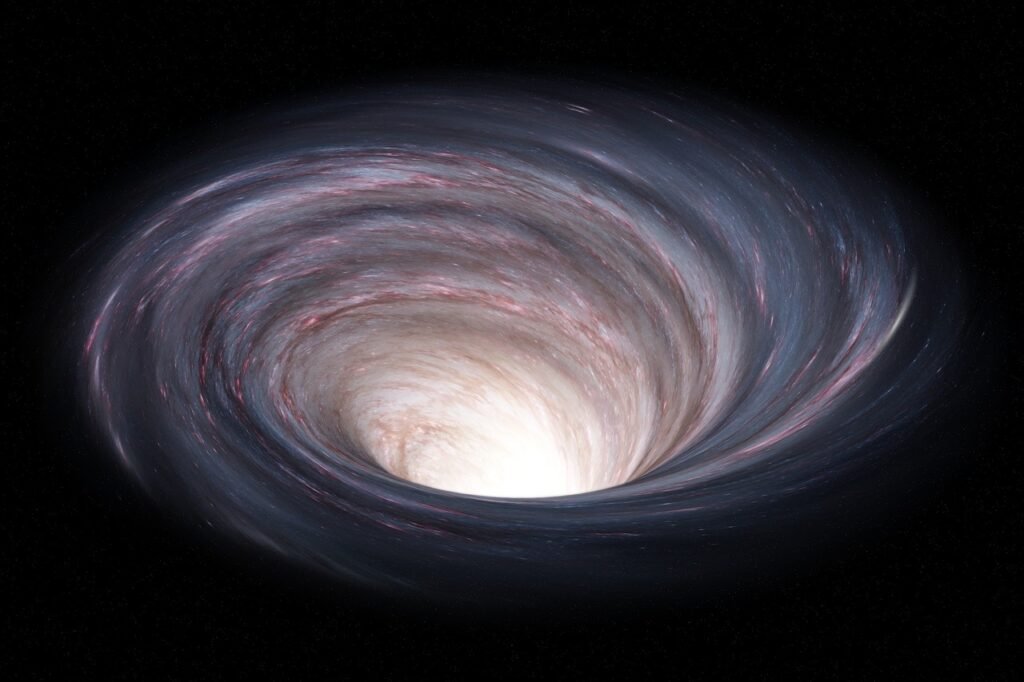The universe holds countless mysteries, yet few capture the imagination quite like black holes. These cosmic monsters have spawned decades of scientific speculation and popular fascination. You’ve likely wondered what happens if someone were to cross that infamous boundary called the event horizon. Recent discoveries in 2025 have brought us closer than ever to understanding these enigmatic objects. Let’s explore what current science reveals about one of the cosmos’ greatest puzzles.
The Event Horizon Barrier

You need to understand that the event horizon represents more than just a boundary. It’s the ‘shadow’ of a black hole, the dark spot that denotes its ‘event horizon,” the boundary beyond which nothing – matter, energy, or even light – can escape its gravitational pull. Think of it like crossing a river where the current becomes impossibly strong. Once you reach that point, there’s no turning back.
As you approach a black hole, the first major feature you encounter is the event horizon. It’s a boundary, but not a physical surface. Cross this invisible threshold, and escape becomes impossible. The truly bizarre part is what happens to time itself. From the outside, time slows down the closer you get. To a distant observer, you would appear frozen in time, inching toward the horizon slower and slower.
Spaghettification and Tidal Forces

If you were unfortunate enough to fall toward a black hole, you’d experience something called spaghettification. Your body would stretch like taffy due to the extreme tidal forces. A TDE happens when an infalling star is stretched or “spaghettified” by a black hole’s immense gravitational tidal forces. The shredded stellar remnants are pulled into a circular orbit around the black hole.
The process isn’t gentle. Your feet would feel a much stronger gravitational pull than your head, creating an incredible stretching effect. Still, the exact experience would depend on the black hole’s size. Smaller black holes create more dramatic tidal effects near their event horizons, while supermassive black holes might allow you to cross the event horizon relatively intact.
The Mystery of Singularities

At the center of the black hole lies the singularity, a point of infinite density where the laws of physics break down. According to Einstein’s general relativity, the singularity is where all the mass of the black hole is concentrated in zero volume. Gravity becomes infinite. Space and time themselves collapse.
However, modern physics questions whether singularities actually exist. We don’t actually know what happens at the singularity. General relativity gives nonsensical answers. Infinite density? Infinite gravity? It’s a sign the theory stops working at this point. The study suggests that black holes may not be singularities but instead highly structured quantum states governed by new laws of physics.
Scientists now believe quantum effects might prevent true singularities from forming. Recent research in 2025 suggests that quantum mechanics could create something entirely different at a black hole’s core.
Hawking Radiation and Information Loss

Stephen Hawking’s groundbreaking work revealed that black holes aren’t completely black. Due to Stephen Hawking’s work, it became known that when general relativity is combined with quantum theory, black holes can emit thermal radiation, which is known as Hawking radiation. This discovery created one of physics’ greatest puzzles.
One of the deepest mysteries in black hole physics is the black hole information paradox. Here’s the problem: According to quantum mechanics, information can’t be destroyed. If you burn a book, you can, in theory, reconstruct its information from the smoke and ashes. But if something falls into a black hole, that information seems to disappear forever. The black hole eventually evaporates via Hawking radiation, leaving no trace of what went in. Where did the information go?
Recent developments in 2025 suggest possible solutions to this paradox. Information, they now say with confidence, does escape a black hole. If you jump into one, you will not be gone for good. Particle by particle, the information needed to reconstitute your body will reemerge.
Quantum States Inside Black Holes

Revolutionary research in 2025 has challenged our understanding of what exists inside black holes. The study suggests that black holes may not be singularities but instead highly structured quantum states governed by new laws of physics. Using quantum matrix models, Rinaldi’s team simulated the lowest energy state of a black hole’s core. Their findings, published in PRX Quantum, reveal that black holes could be complex quantum systems rather than infinitely dense points.
This means that instead of finding a point of infinite density, you might encounter a highly organized quantum structure. Think of it like discovering that what appeared to be a solid wall was actually made of intricate, moving patterns. This challenges the traditional view of black holes as singularities, where gravity becomes infinite and the laws of physics break down. Instead, the research suggests that black holes have a structured interior, governed by principles we are only beginning to understand.
Laboratory Simulations of Event Horizons

Scientists in 2025 have achieved remarkable progress by creating black hole analogs in laboratory settings. In a groundbreaking experiment, physicists have simulated the enigmatic phenomena of black holes in a laboratory setting, shedding light on the elusive concept of Hawking radiation. Utilizing a linear chain of atoms to mimic the event horizon of a black hole, researchers observed behavior analogous to the theoretical particles thought to emanate from black holes.
These experiments don’t create actual black holes, but they produce conditions that mimic their quantum behavior. Scientists used a one-dimensional chain of atoms, allowing electrons to ‘hop’ from one position to another. By manipulating the ease of this hopping, they created a synthetic event horizon that interacted with the quantum wave-like nature of the electrons. These laboratory studies provide crucial insights into what might happen near real event horizons.
The Holographic Principle

Perhaps the most mind-bending aspect of modern black hole physics is the holographic principle. From an outside perspective, all the information about what fell into the black hole seems to be stored on its surface, on the event horizon itself. This idea leads to some of the wildest concepts in physics.
The holographic principle suggests something extraordinary about reality itself. The holographic principle suggests that everything happening inside the black hole could be encoded on its surface, like a cosmic hologram. This means that all the three-dimensional information inside a black hole might actually exist as two-dimensional information on its surface. If true, this would revolutionize our understanding of space, time, and information itself.
White Holes and Bouncing Universes

Recent theoretical work has proposed that black holes might not be endpoints but rather transitions to something else entirely. While black holes are often described as sucking everything, including time, into a point of nothingness, in the paper, white holes are theorised to act in reverse, ejecting matter, energy and time back into the universe.
Some researchers suggest our entire universe might actually exist inside a black hole. The paper suggests the Big Bang was actually a ‘Big Bounce’, when matter falling into a giant black hole compressed, then rebounded and expanded outwards to create the Universe. “In other words, our entire observable Universe could be the inside of a black hole formed in a larger Universe,” Gaztañaga told BBC Science Focus. This radical idea would mean you’re already living beyond an event horizon.
Magnetic Fields and Energy Extraction

Modern research has revealed that black holes are far from simple objects. Scientists have simulated how M87*, the supermassive black hole at the center of the galaxy M87, powers its immense particle jet. The Frankfurt team’s FPIC code shows that magnetic reconnection, where magnetic field lines snap and reform, works alongside the traditional Blandford-Znajek mechanism to release rotational energy. These findings shed new light on how black holes energize the cosmos and shape galaxies.
At the heart of the giant galaxy M87 lies the black hole M87*, which contains a staggering six and a half billion solar masses and spins rapidly on its axis. Using the energy from this rotation, M87* powers a particle jet expelled at nearly the speed of light, stretching across an immense 5,000 light-years. Such jets are also generated by other rotating black holes. They contribute to disperse energy and matter throughout the universe and can influence the evolution of entire galaxies.
Recent Discoveries and Future Observations

The field of black hole physics continues to advance rapidly. Event Horizon Telescope images of black hole shadows provide a sensitive method to search for dark matter. The shadowy regions in black hole images captured by the Event Horizon Telescope can act as ultra-sensitive detectors for the invisible material that makes up most of the universe’s matter. The Event Horizon Telescope’s stunning images of supermassive black holes have revealed more than just the geometry of spacetime; they’ve opened an unexpected window into the search for dark matter.
Scientists are now working on creating the first movies of black holes. A professor of astroparticle physics and radio astronomy at Radboud University in the Netherlands, Falcke is one of the leads of the Event Horizon Telescope (EHT), a global network of telescopes that captured the first image of a black hole in 2019. Together with his colleagues, he now wants to go further and create the first video of these incredible and mysterious space objects. Gaining further knowledge of black holes will be crucial to our understanding of the universe, Falcke said, and the new BlackHolistic project, which will run until 2029, should provide vital clues.
The journey to understand what lies beyond a black hole’s event horizon continues to challenge our deepest assumptions about reality. From quantum states that might replace singularities to laboratory simulations that recreate event horizon conditions, science is gradually peeling back the mystery. The latest research suggests that crossing an event horizon might not be the one-way journey to oblivion we once imagined. Instead, it could be a gateway to understanding the fundamental nature of space, time, and information itself.
What do you think about the possibility that information might actually escape from black holes? Tell us in the comments.

Jan loves Wildlife and Animals and is one of the founders of Animals Around The Globe. He holds an MSc in Finance & Economics and is a passionate PADI Open Water Diver. His favorite animals are Mountain Gorillas, Tigers, and Great White Sharks. He lived in South Africa, Germany, the USA, Ireland, Italy, China, and Australia. Before AATG, Jan worked for Google, Axel Springer, BMW and others.



